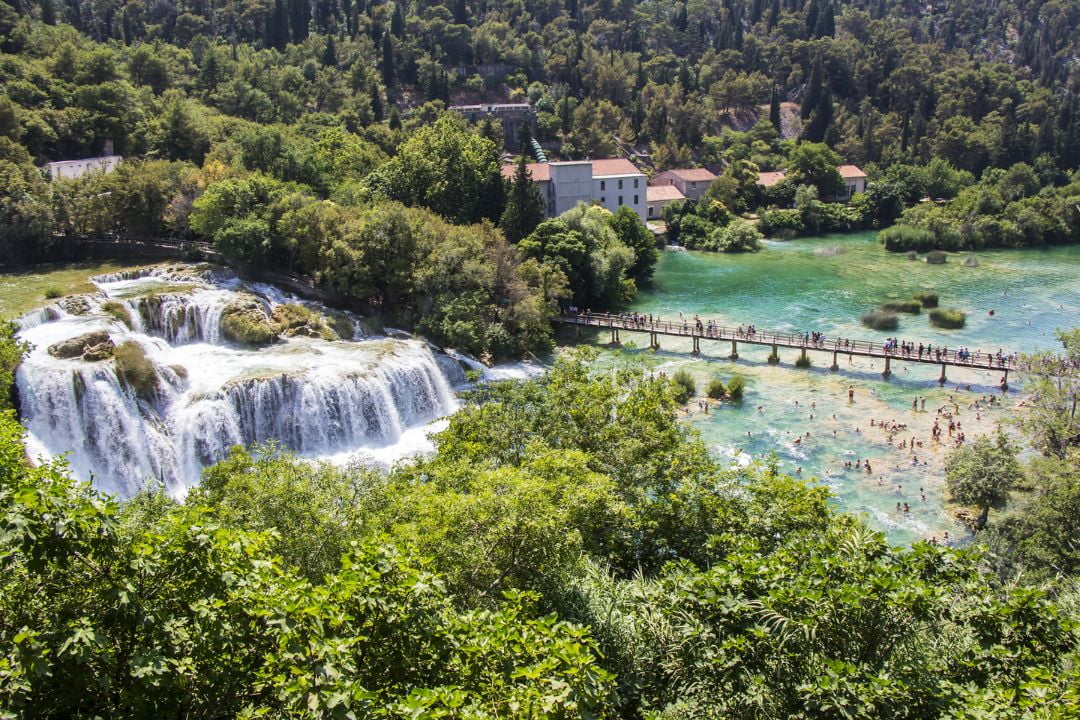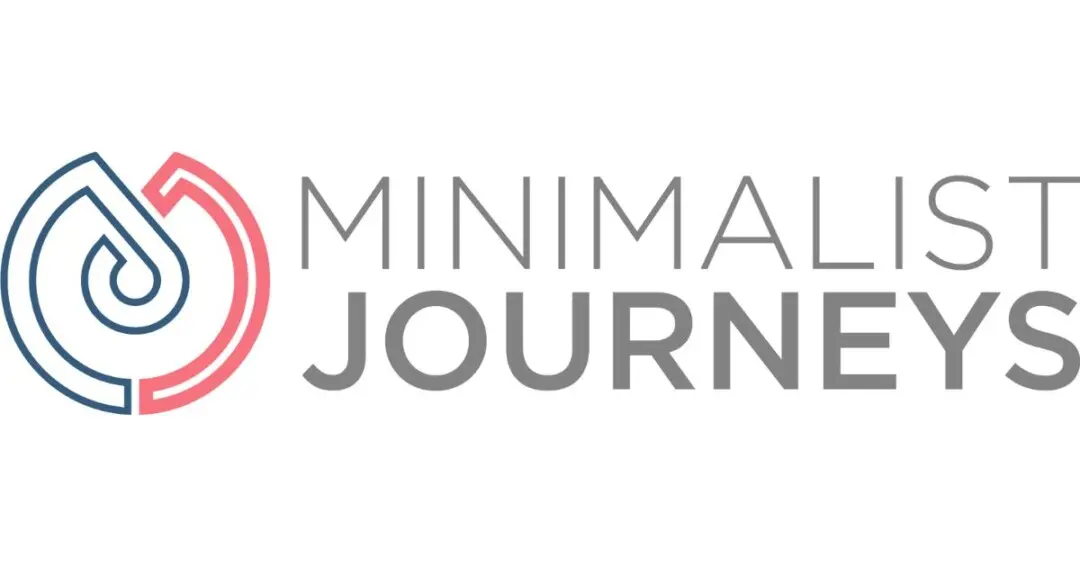This article may contain links to products and services we use and recommend. We may receive compensation when you click on links to those products. For more information, see our Disclosure Policy.
Those of you who follow us know how much we love waterfalls. We’ve been there: Iguazu, Niagara Falls, Semuc Champey… you name it. Recently, we explored Plitvice Lakes, and there was absolutely no question: We would also check out Krka National Park in Croatia. Not only did we have an awesome time, but we can now provide in-depth advice, having experienced both.
While not a UNESCO world heritage site like Plitvice Lakes or Dubrovnik, the easy-to-reach sights at Krka are getting more than their fair share of tourists in summer. If you’d like to experience Krka National Park without crowds (and without a car), this post is for you.
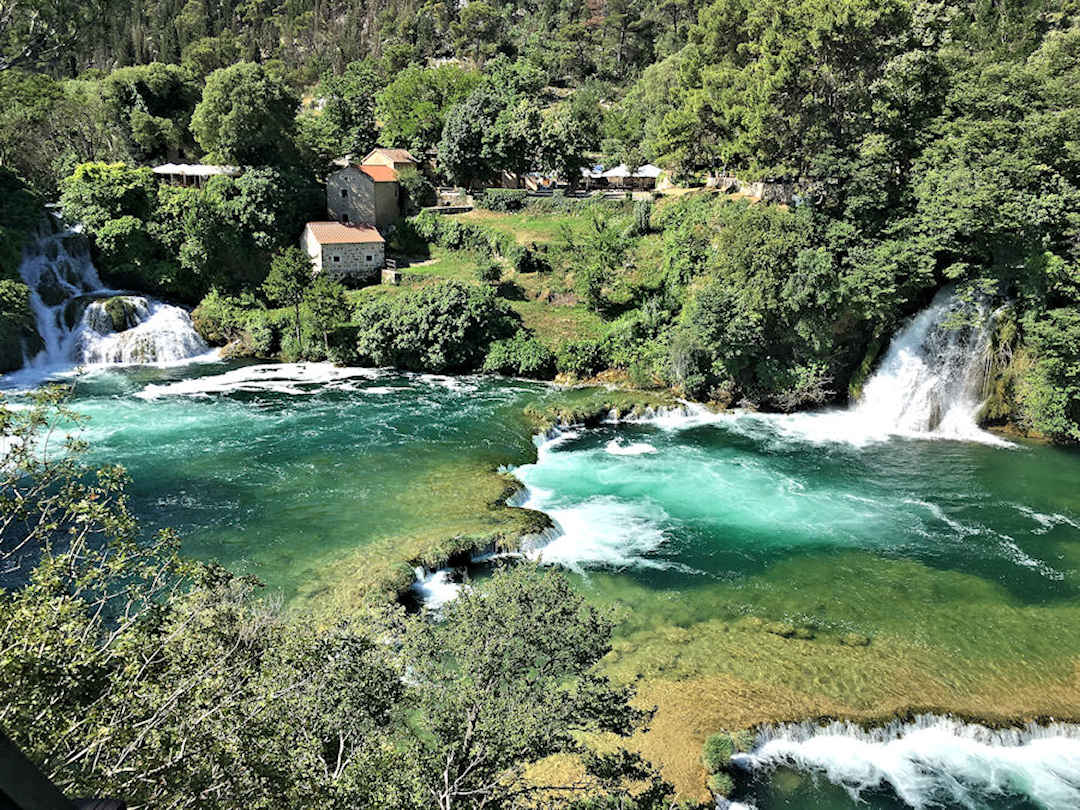
Designated in 1985, Krka is Croatia’s second most visited National Park
Why is Krka National Park so popular?
Krka is Croatia’s second-most visited National Park (after Plitvice Lakes) and has been a designated natural heritage site since 1985. Just over 100 square kilometres, the park is only one-third the size of its more famous sibling, yet it feels more extensive, as Krka’s main sights are more spread out.
When people talk about Krka National Park, they often have the park’s most expansive and most photographed waterfall in mind: Skradinski Buk [Google Maps location]. It is stunning, no question, and you are even allowed to bathe in the river just below the falls. But what makes Krka so attractive to many is how easy it is to get to. It’s a 30-minute drive from Sibenik and less than 90 minutes from Split. This means most people visit on a day trip, and Skradinski Buk is all they get to see.
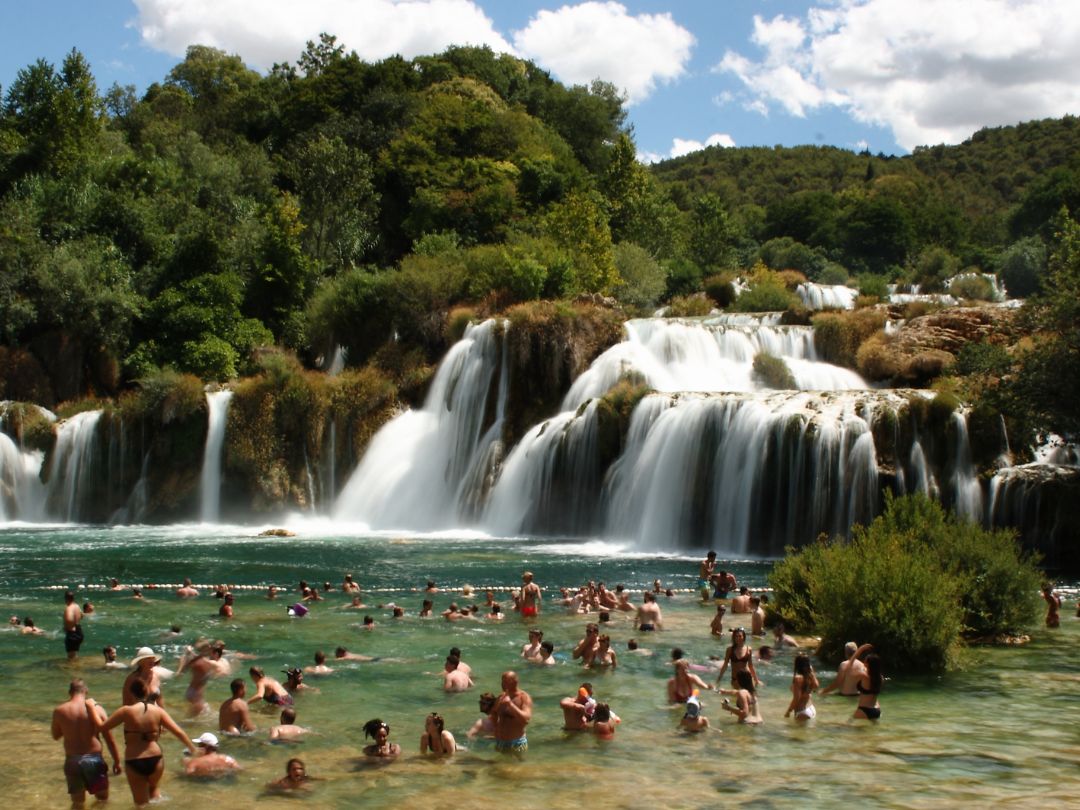
This is now a scene from the past. As at 01 January 2021, there is a swimming ban at Krka National Park. Most people visit Krka on a day trip, and Skradinski Buk is all they get to see
Krka National Park (thankfully) is more than Skradinski Buk. The park stretches from the outskirts of Knin in the north to the small town of Skradin in the south, along the Krka river valley, which slowly descends towards the Adriatic over seven travertine waterfalls. Skradinski Buk is the final and widest one of the seven.
Map of Accommodation, Points of Interest, Eateries and Transport
Below is a map of the recommended accommodations, points of interest, eateries, and transport terminals or stops mentioned in this article.
But visitors come to admire more than beautiful waterfalls. The park is also a resting point for birds on their twice-annual migration between Europe and Africa. It is home to medieval monasteries, fortresses, and archaeological sites that date back to Roman times.
The countries that once made up the former Socialist Federal Republic of Yugoslavia (SFRY) have a hugely complex history. It took us nearly three months of travels through Slovenia, Croatia, Montenegro, Bosnia and Herzegovina, and Serbia to gain some understanding of what happened here (and why).
At the Srebrenica Genocide Memorial in Bosnia and Herzegovina, we learnt what happened there and how to honour the victims. Our guide provides everything you need to know.
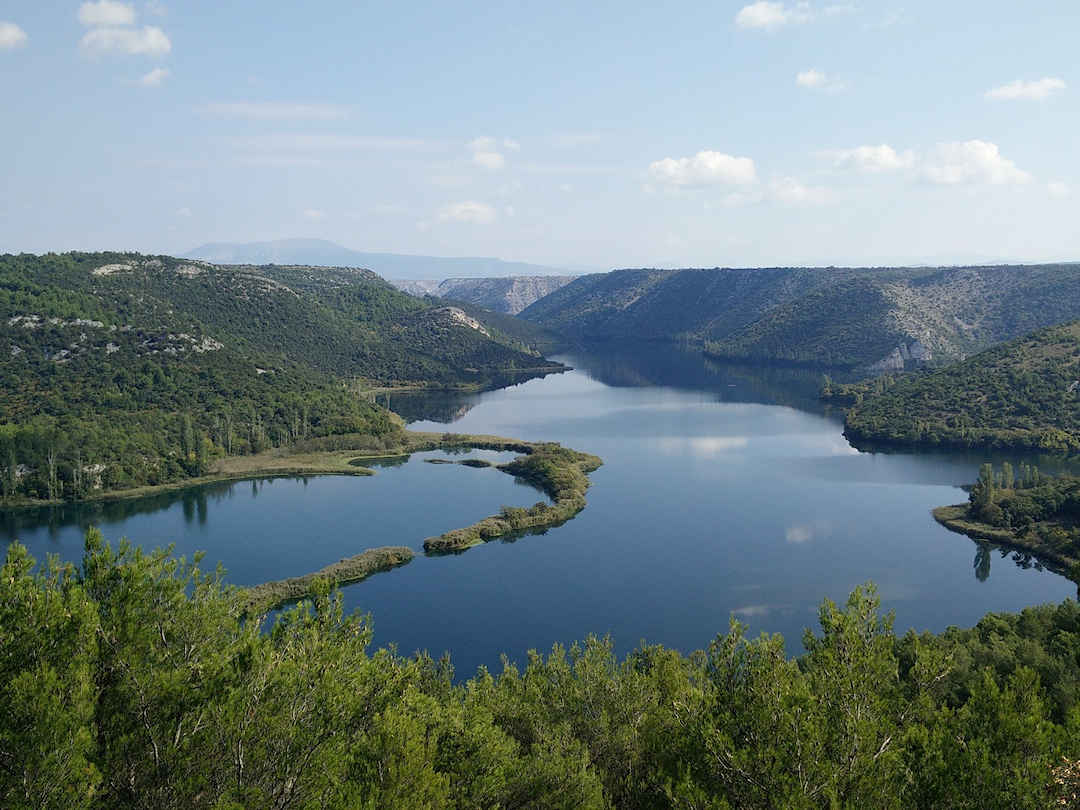
Upriver from Skradinski Buk is where the untouched Krka starts
Which National Park is better – Krka or Plitvice Lakes?
As our guide for Plitvice Lakes mentioned, both parks are very different, making a comparison almost impossible. The main differences between Krka and Plitvice Lakes are:
- You can bathe at Krka National Park in a designated area at Skradinski Buk. Many people do that in summer so that you might share the natural pools with hundreds of others.
- Krka is more versatile than Plitvice Lakes, with plenty to keep you busy for days: gorgeous waterfalls, tranquil boat rides through deep river canyons, hiking and mountain bike trails, medieval monasteries and fortresses, and even Roman archaeological sites if that’s your thing.
- Because the main sights at Krka are pretty spread out, exploring the park without a car is more challenging, and you need more time to see than Skradinski Buk.
If you want to visit both (on the same trip) and are looking for an order, we recommend visiting Krka first and then Plitvice Lakes National Park.
Krka has plenty to keep you busy for days, including tranquil monasteries like this | Image courtesy of Hrvoje Klaricon on Unsplash
When is the best time to visit Krka National Park?
As with most places around the Mediterranean, and Croatia in particular, avoid the peak summer months. Half of Europe seems to flock to the Adriatic during the school holidays in July and August. Entry tickets are the most expensive between June and September.
Instead, come here in the shoulder months of April/May or October, if you can, when the temperatures are pleasant but less crowded and expensive. The added benefit: Spring and autumn are beautiful times of the year to come here and experience the blooming of the trees and wildflowers in spring and the colouring of the trees in autumn.
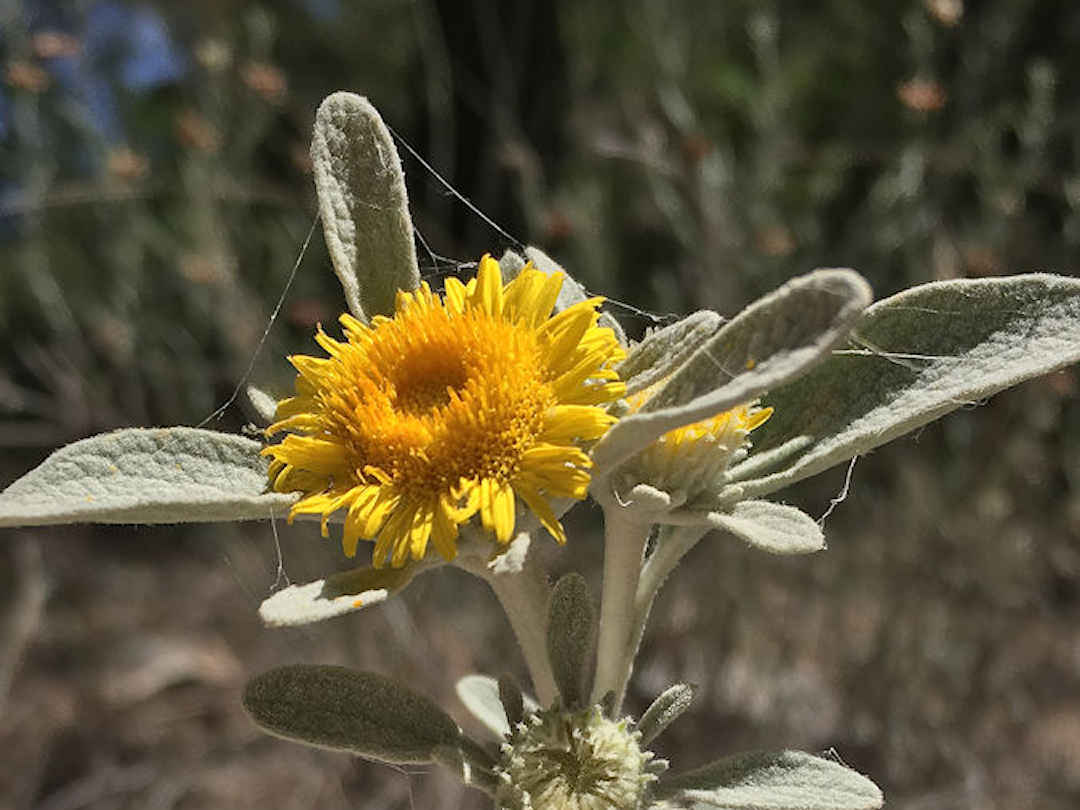
Visit Krka in Spring to experience the blooming of the trees and wildflowers
You could even come in the winter months between November and March when it’s cheapest, but be aware that the boat and bus services that bring you to the main sights during the rest of the year are not available in Winter, which means having a car is pretty much unavoidable
How do I get to Krka National Park (without a car)?
Krka National Park is about halfway between Zadar and Split, around 20km inland from the Adriatic coast and Sibenik. The park has entrances at five locations. The most important ones for independent travellers are
- those near Skradin and Lozovac in the south (which are closest to Skradinski Buk) and
- those by Roški Slap (near the settlement of Laškovica) about 20km upriver towards the town of Knin.
As mentioned above, one of Krka’s biggest drawcards is how easy it is to get there. Buses from Sibenik to Skradin take around 30 minutes – check out the timetable to Skradin and from Skradin. You can also reach Skradin from Zadar in about an hour and Split in less than 1 1/2 hours. The bus journey between Plitvice Lakes and Skradin takes about 3 hours.
Onward bus tickets can be bought from the booth at the bus stop (coming from Zadar) or at Active Destination, a travel agency in town.
How do I get around the park, and what are the trails like?
As mentioned, there are seven waterfalls in total, but the easiest ones to visit (without a car) are Skradinski Buk and Roški Slap.
Skradinski Buk
The settlement of Lozovac is within walking distance from Skradinski Buk (~1.5km). From April to October, there is also a shuttle bus – the return journey is included in your entry ticket.
If you come from Skradin, you have two options:
- From April to October, a boat shuttle service includes the return journey in your entry ticket. The boat leaves from the jetty in Skradin (a few steps behind the visitor centre) and takes about 30 minutes each way.
- You can also walk or cycle between Skradin and Skradinski Buk. The 4.5km trail runs parallel to the river (along its northern shore) and offers some lovely views along the river valley.
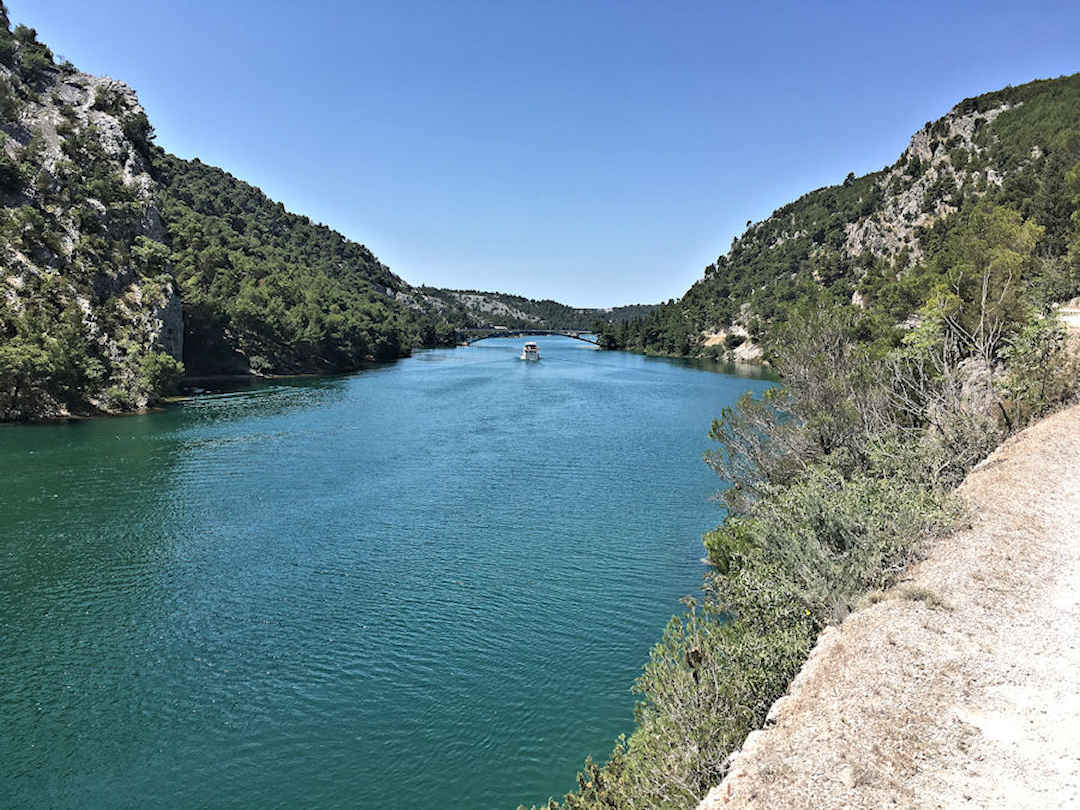
You can reach Skradinski Buk from Skradin by boat shuttle or by walking or cycling the 4.5km trail along the river
Once at Skradinski Buk, there is an easy 2km loop trail, a mix of gravel/forest trail, some cobblestone paths and boardwalks to explore everything there is to see. The trail takes you past restored mill houses (which now contain exhibitions and souvenir shops) and the remains of the old hydroelectric plant, over the waterfall and to the different viewpoints. Information boards also explain the flora and fauna of the area dotted along the trail. The route is quite undulating (with some steps), which might be challenging to navigate with a wheelchair or stroller, though some parts of Skradinski Buk are wheelchair and stroller accessible (and there are signposts to direct you accordingly).
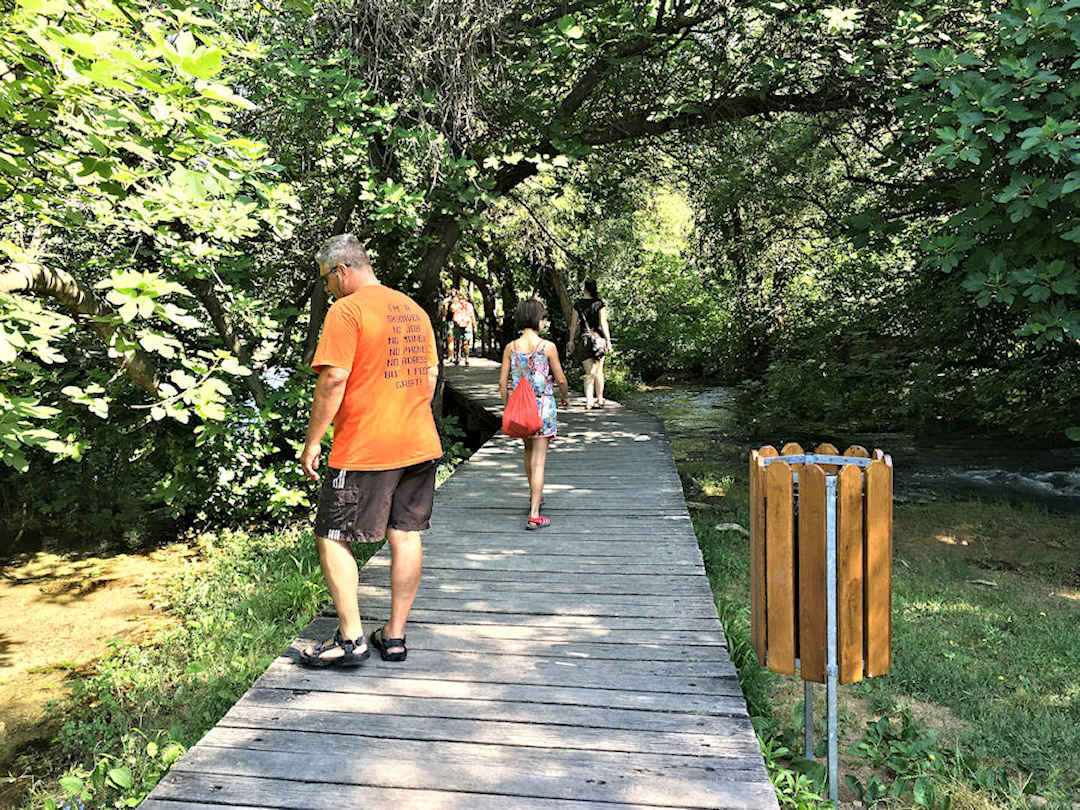
The loop trail at Skradinski Buk is a mix of gravel/forest trail, some cobblestone paths and boardwalks
Roški Slap
To explore more of the park you need to bring your own mode of transport (a mountain bike, for example – more on that below) or join one of the boat excursions that connect
- Skradinski Buk with Visovac Monastery, Roški Slap and Oziđana Pećina Cave; and
- Roški Slap with Krka Monastery, and the medieval fortresses of Nečven and Trošenj.
The boat excursions are not included in your entry ticket.
The jetty for the boat excursion to Visovac Monastery and Roški Slap is located upriver from Skradinski Buk, about 500m along the Lozovac shore. The jetty for the boat excursion to Krka Monastery is about 500m upriver from Roški Slap, near the trailhead to the Oziđana Pećina Cave. There are signs between the jetties so don’t worry, you can’t get lost.
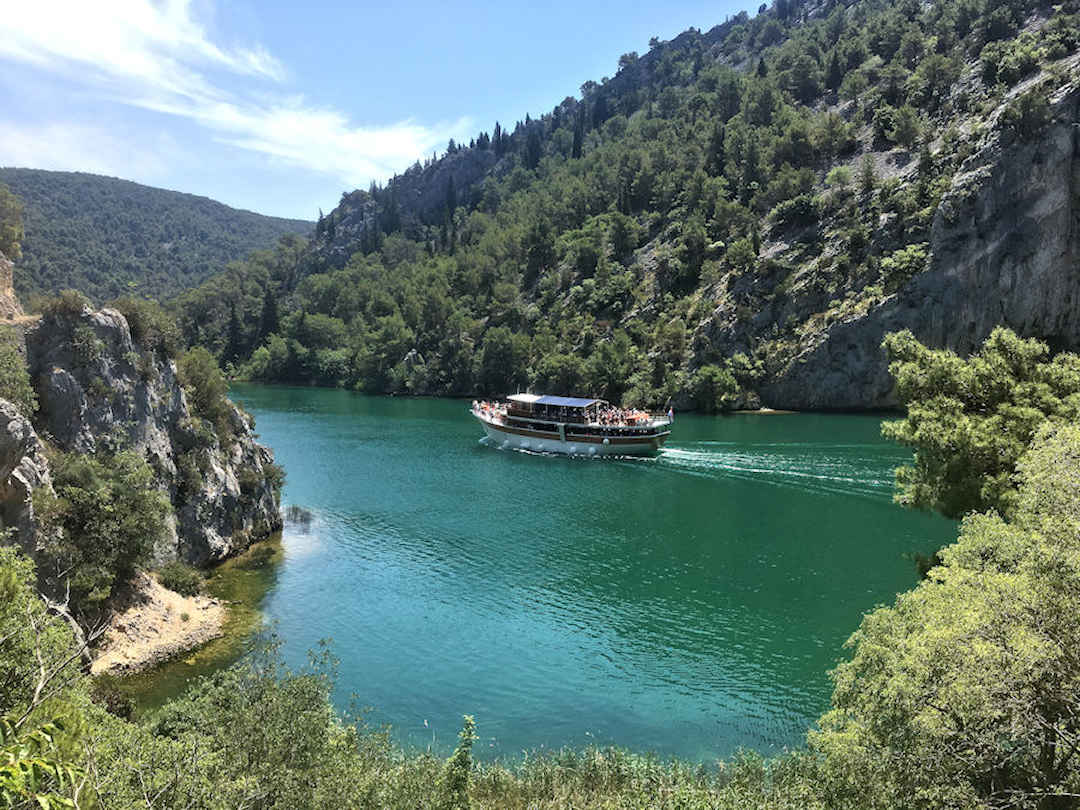
Boat excursions connect Skradinski Buk with Visovac Monastery and Roški Slap, and Roški Slap with Krka Monastery
You can also reach Roški Slap by mountain bike, taking the R1 route through Dubravice, Rupe and Laškovica. You can hire mountain bikes in Skradin. If you think, ‘Why not combine both?’ be warned: It is currently impossible to cycle to Roški Slap and then take the boat excursion back (or vice versa). S,o make sure you have enough energy to cycle both ways. It’s approximately 35 kilometres return from Skradin (if you return the same way) with approximately 900m elevation gain.
Upper Falls and Burnum Archaeological site
The northernmost sights of the park, comprising the five upper falls – including Manojlovac Slap (the tallest waterfall at Krka) – and the Roman archaeological site of Burnum, can only be reached by car or (if you have the stamina) by mountain bike. In total, Krka boasts over 470km of cycling trails.
Three gorgeous, less crowded and more affordable alternatives to Dubrovnik
With Dubrovnik suffering from too much love, check out Dalmatian coastal cities with stunning Old Towns and UNESCO Sites.
How much time do I need to visit Krka?
How much time you should set aside for your visit really depends on what you want to see.
If you just want to see and (maybe bathe) at Skradinski Buk you can do that easily on a day trip. If you need to store your luggage for the day, Active Destination offers a luggage storage service. Otherwise, just take a stroll through town and look for signs as some of the hotels also offer luggage storage to non-guests.
If you’d like to see Skradinski Buk and Roški Slap and have the option to visit the monasteries, we recommend staying at least one night. This gives you the chance to experience Skradinski Buk in the morning without the crowds and join a boat excursion from there to Roški Slap (note: you need to book excursions in advance). Add even more days if you’d like to explore the park’s 470km of cycling and 47km of hiking trails.
Either way: Be aware that the operating hours of the park vary by season. So make sure you check those before you book anything else.
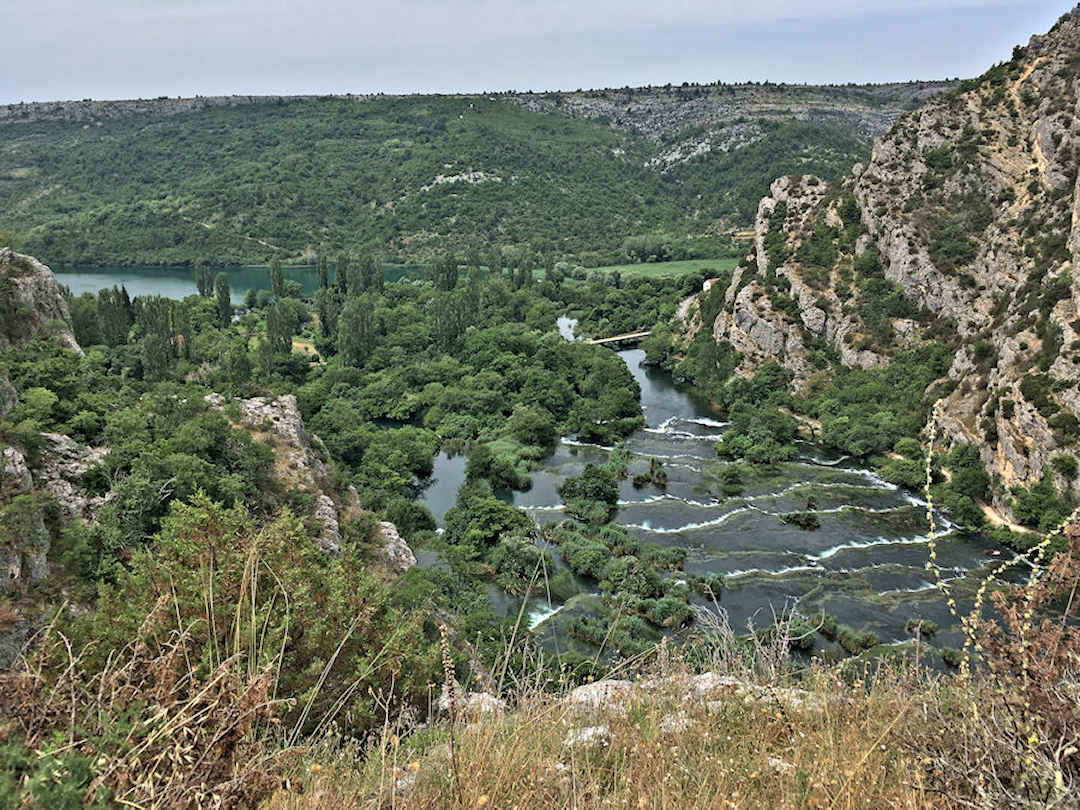
If you want to see Skradinski Buk and Roški Slap (and maybe a monastery or two) stay at least a night at Krka
Is there an entrance fee? How does ticketing work?
Croatia’s natural heritage requires protection, and protection needs funding. So yes, there are entrance fees.
Similar to Plitvice Lakes, you have the choice between a single entry ticket that allows you to visit the park for the day or a multi-day ticket. In Krka’s case, the multi-day ticket allows you to visit the park for 3 days over a 7-day period, perfect if you’re planning to spend a week in the area but don’t want to be in the park every day.
You can buy entry tickets for Krka National Park online via the same website you can buy tickets for Plitvice Lakes or at the park offices located near the entrances. We bought ours at the Visitor Centre in Skradin.
When we visited in June 2019, the Visitor Centre only sold tickets for the same day. As boats only start operating when the park opens, we headed to the Visitor Centre right when it opened (an hour before the park) to make sure we caught the first boat.
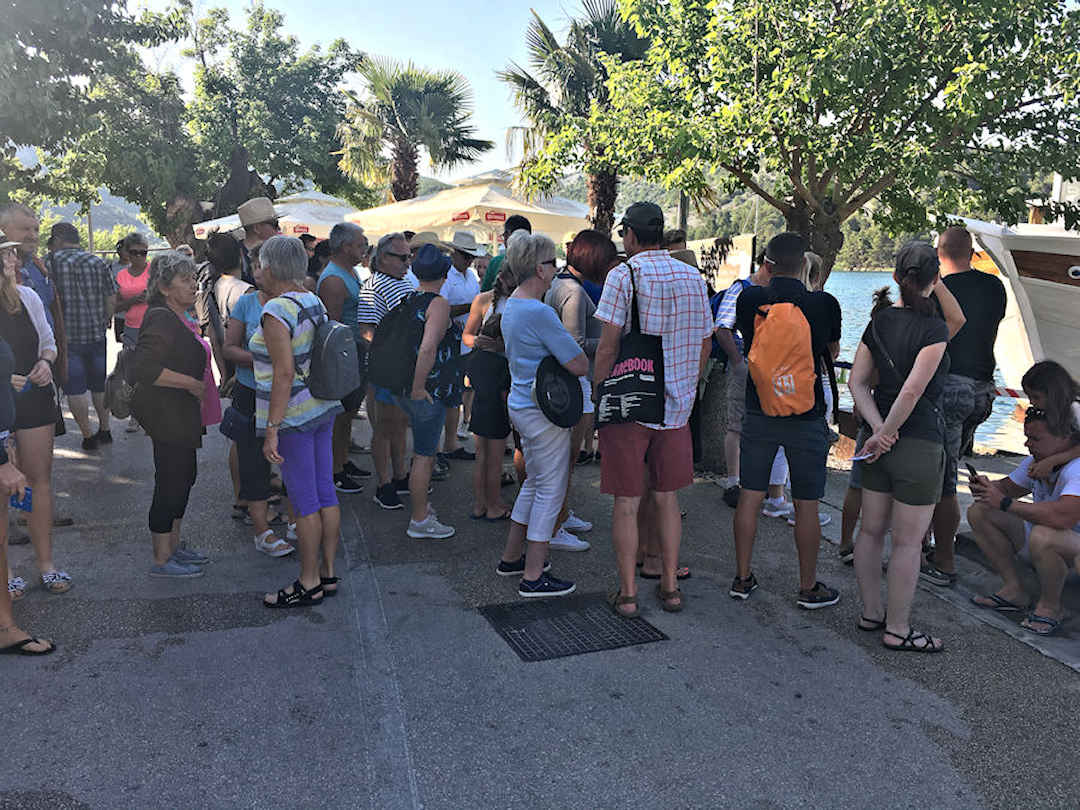
A small crowd gathering for the first boat of the day - two hours later the boats are packed
If you want to experience Skradinski Buk earlier (without another soul in sight), buy your ticket online, hire a bike and ride to Skradinski Buk as soon as the sun rises.
Also, note that visitor numbers at Krka National Park are limited to 10,000 at any one time. So, if you’re visiting in the summer months make sure you book your entry tickets online (a few days) in advance to avoid disappointment.
Where do I stay/eat at Krka National Park (without a car)?
Within the National Park
There is no accommodation option within Krka National Park (that we’re aware of). Hotel Roški Slap, located in the middle of the falls, doesn’t appear to be open for bookings any more, but we did have lunch in its tranquil beer garden.
While it lacks accommodation options within the park compared to Plitvice Lakes, Krka makes up for it with dining options.
At Skradinski Buk
There is a great variety of food stalls dotted around a large beer garden on the side of the falls where the boat from/to Skradin docks. Food is prepared in front of you (the pancakes are yummy) or available for purchase (including freshly baked sweet and savoury pastries) without nasty packaging. There is also a restaurant with views over the falls on the Lozovac side of the falls, though we can’t comment on the food quality/prices.
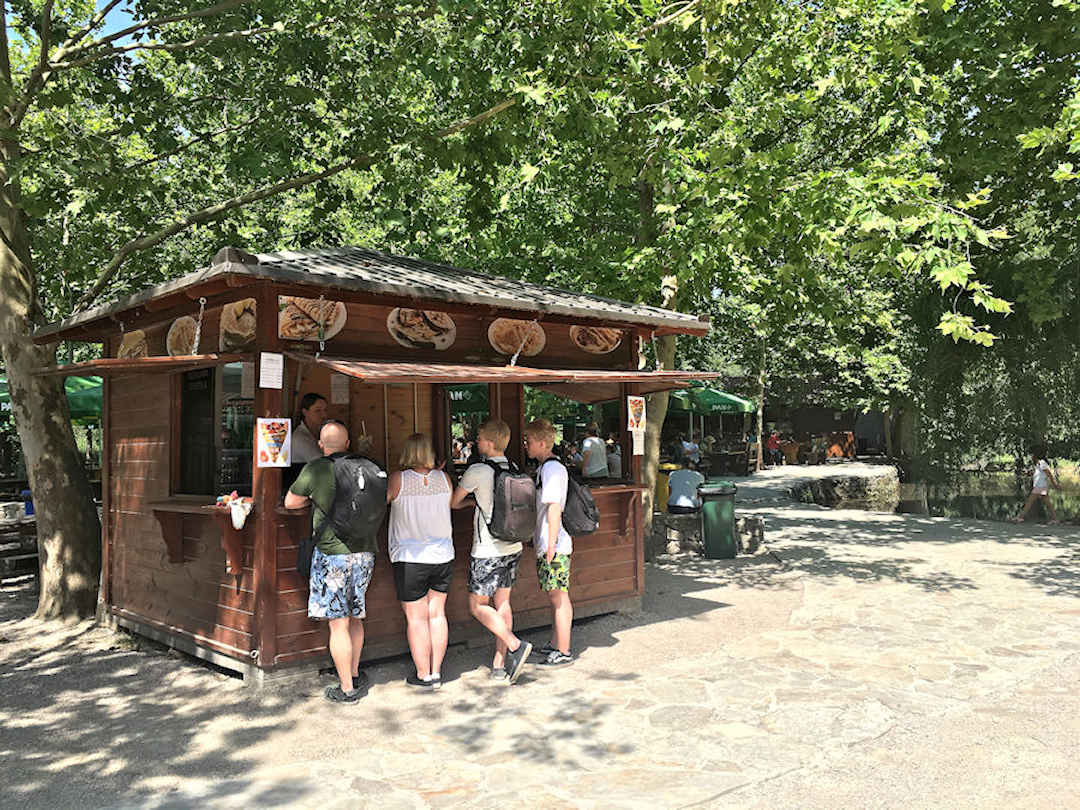
Krka has many food options including food stalls and a restaurant at Skradinski Buk, and several restaurants at Roški Slap
At Roški Slap
You can choose between two restaurants/beer gardens – Seosko Domacinstvo Kristijan [Google Maps location] or Alte Muhle Kristijan [Google Maps location].
Bins (including recycling) are available all around the park. We also saw two water fountains, on either side of Skradinski Buk.
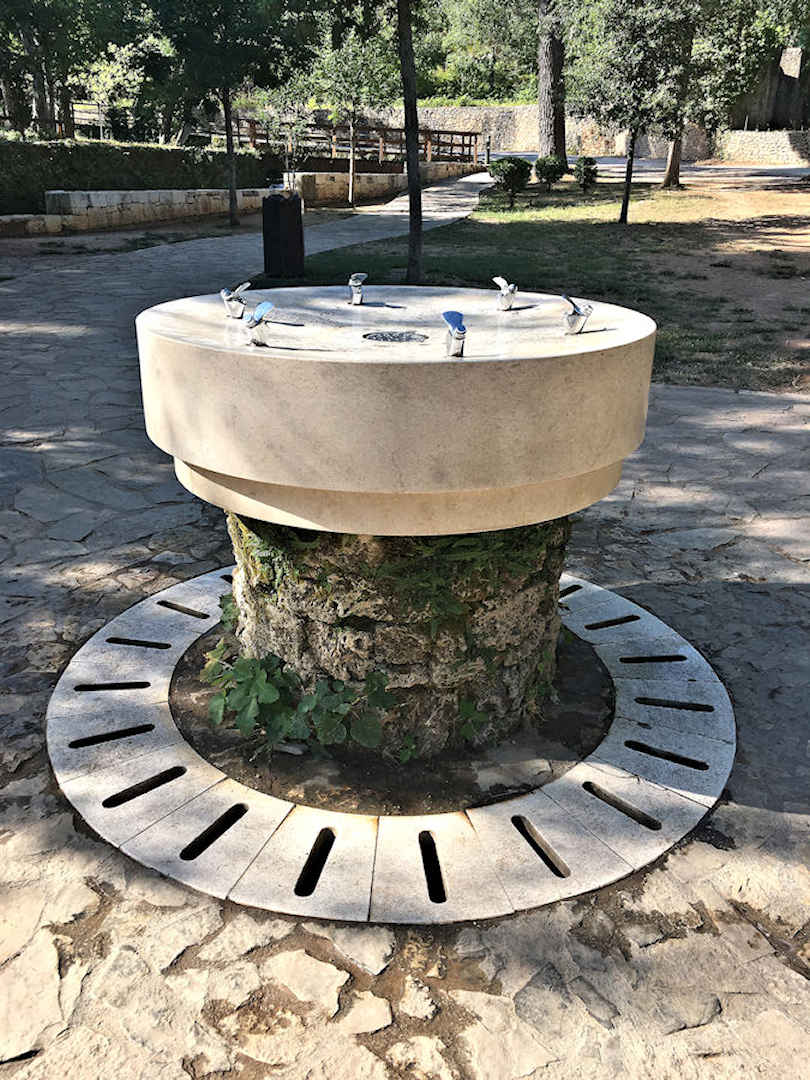
Water fountain at Krka National Park
Outside the park
Since public transport only serves the vicinity of Skradinski Buk, we won’t list accommodation options further north.
The two settlements closest to Skradinski Buk are Lozovac and Skradin. From Lozovac, you can reach Skradinski Buk by walking approximately 1.5km or taking the bus shuttle (which operates between April and October). Reaching Skradinski Buk from Skradin requires a 30-minute boat ride (between April and October) or a 4.5-kilometre bike ride/walk.
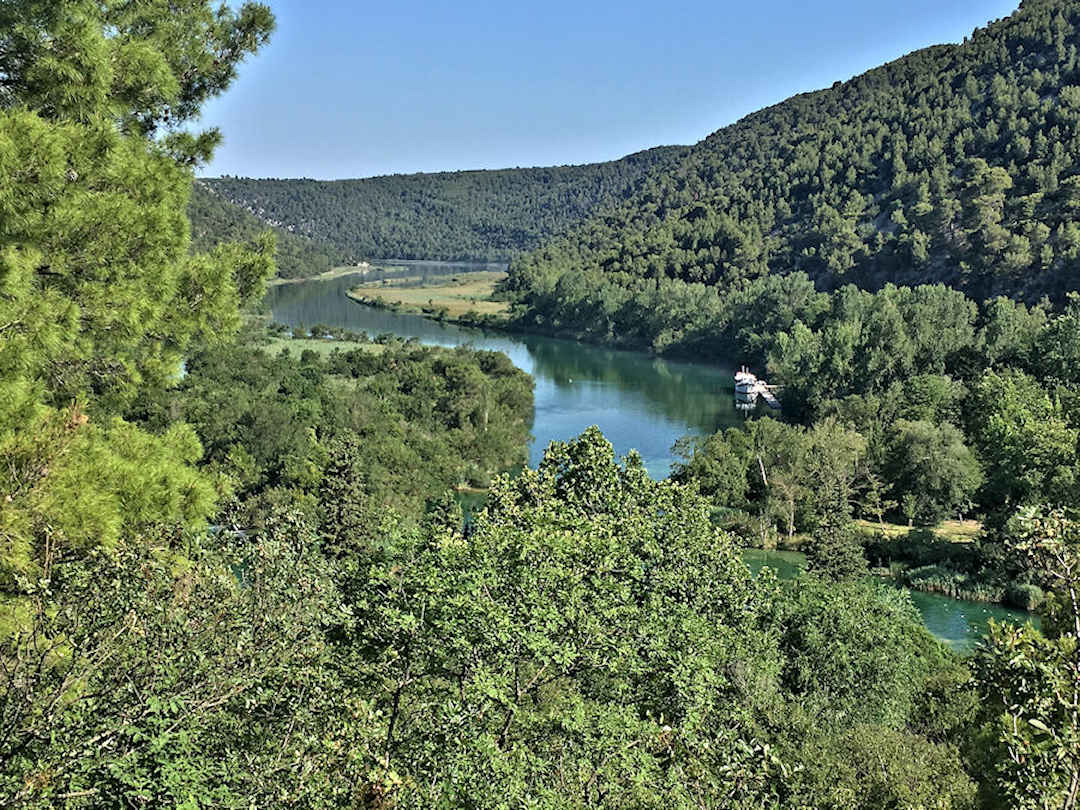
The two settlements closest to Skradinski Buk are Lozovac (walk or bus shuttle) and Skradin (boat shuttle, cycle or walk)
While Lozovac is closer on paper, it has less character than Skradin and is more challenging to get to. Only the local bus to/from Sibenik stops in Lozovac – check the timetable here (from Sibenik to Sibenik). Lozovac lacks a decent-sized supermarket, so bring your groceries here if you want to self-cater.
If you come by bus from afar, your best choice is Skradin. The small town has charm, a stunning waterfront location and several historic sights. We can highly recommend spending a few days here. Skradin has several supermarkets, making self-catering even for more extended periods very easy.
Below is a summary of my recommended accommodation options for staying near Krka National Park.
| Name | Property Features | Location | Type | Price Indicator | Book Now |
|---|---|---|---|---|---|
| Apartment Karla SNB | Certain documented environmental practices implemented at property. Saltwater pool | Lozovac | Two Bedroom Apartment | $$ | Book Now |
| Guesthouse Villa DomeNico | 4-stars 1.5km from Krka Waterfalls Free bike rental | Lozovac | Guesthouse | $$$ | Book Now |
| Hotel Vrata Krke | 3-stars Certain documented environmental practices implemented at property. Onsite-restaurant | Lozovac | Hotel | $$ | Book Now |
| Apartment Balinovaca | 3-stars Certain documented environmental practices implemented at property Self-catering accommodation | Skradin | Apartment | $ | Book Now |
| Guest House Ankora | 3-stars Certain documented environmental practices implemented at property. | Skradin | Guesthouse | $$ | Book Now |
| Skradin Airbnb | Super-equipment kitchen Modern bathroom | Skradin | One bedroom apartment | $$ | Book Now |
| Vila Marija | 3-stars Restaurant Certain documented environmental practices implemented at property. | Skradin | Guesthouse | $$ | Book Now |
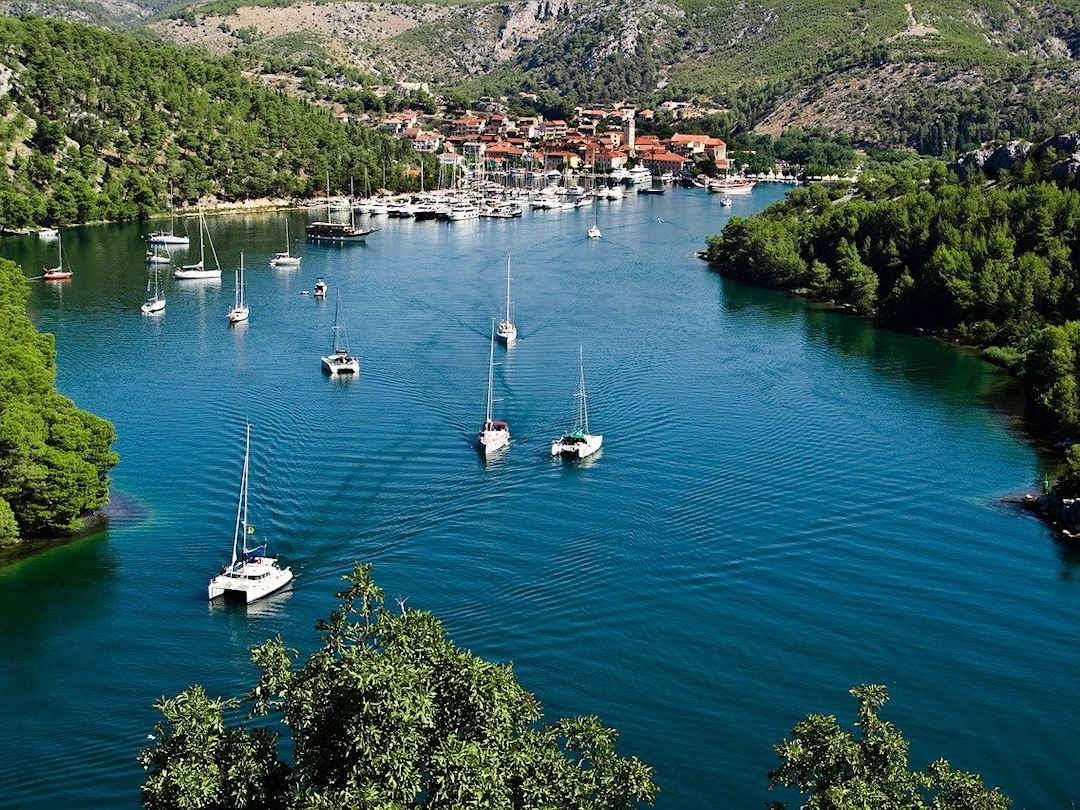
Charming Skradin was a real surprise - a destination in its own right worth exploring | Photo by Jacek Abramowicz on Pixabay
How do I best visit Krka National Park (without crowds or a car)?
Day visit
If you’ve only got time for a day visit, we recommend visiting outside the peak season (June-September).
If you can’t, take an early bus to Skradin from Sibenik, Zadar or Split (or to Lozovac from Sibenik) and head straight to Skradinski Buk. We recommend arriving later in the afternoon if you can’t be there when the park opens. Entry tickets are discounted from 16:00, and most day visitors leave around 17:00.
Joining a day tour from Sibenik, Zadar, or Split is also an option.
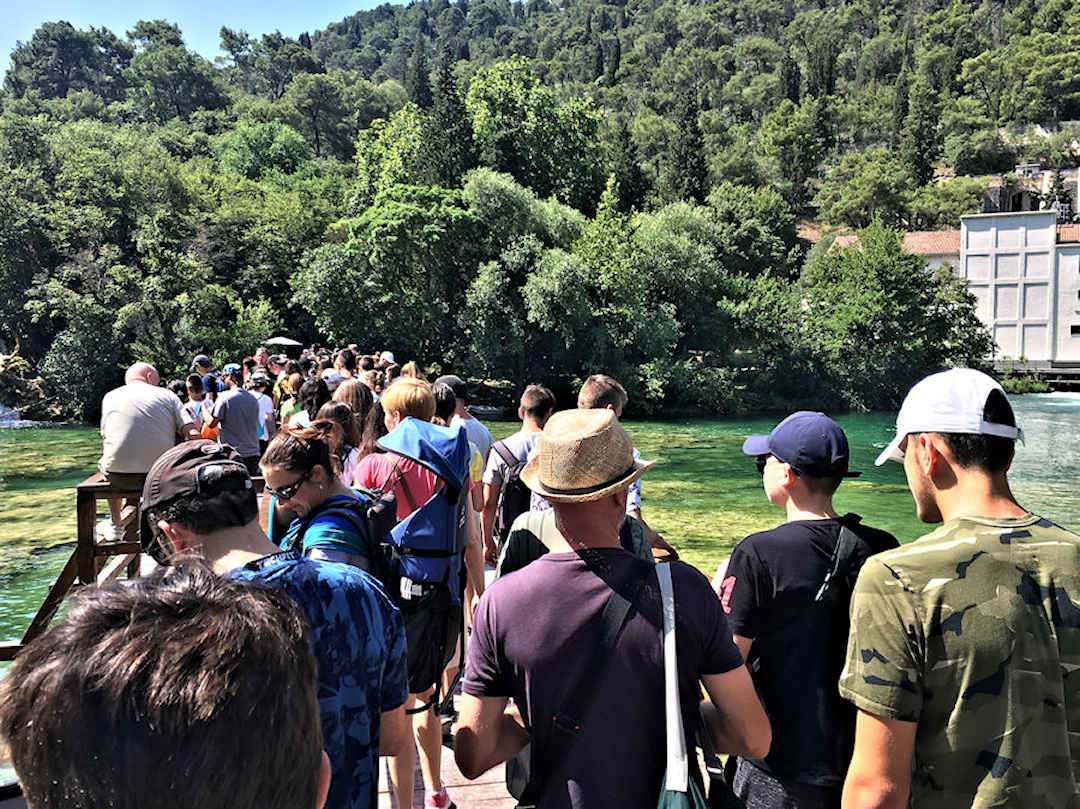
What a difference two hours can make - Skradinski Buk went from empty to this when we visited in June
If you stop over for the day (on your journey between Zadar and Split, for example) and need to store your luggage, Active Destination and several of the hotels in Skradin offer a luggage storage service (keep an eye out for the signs).
Stay one night
We recommend staying at least one night if you’d like to see Skradinski Buk (in the morning without the crowds), a medieval monastery, Roški Slap, and a cave dating back to the neolithic age (5,000 BC).
Arrive in the afternoon or early evening and explore Skradin. Head up to the ruins of Turina Fortress for sunset. Then, enjoy freshly caught seafood or the local speciality, Skradinski Rižot, at one of the town’s many restaurants.
If you don’t have your entry ticket, buy it when the Visitor Centre opens the following day. Then, take the boat or hire and ride a bike to Skradinski Buk and explore this stunning waterfall on the loop walk. Make sure you check out the exhibitions in the restored mill houses. Exploring the falls will take you 2-3 hours.
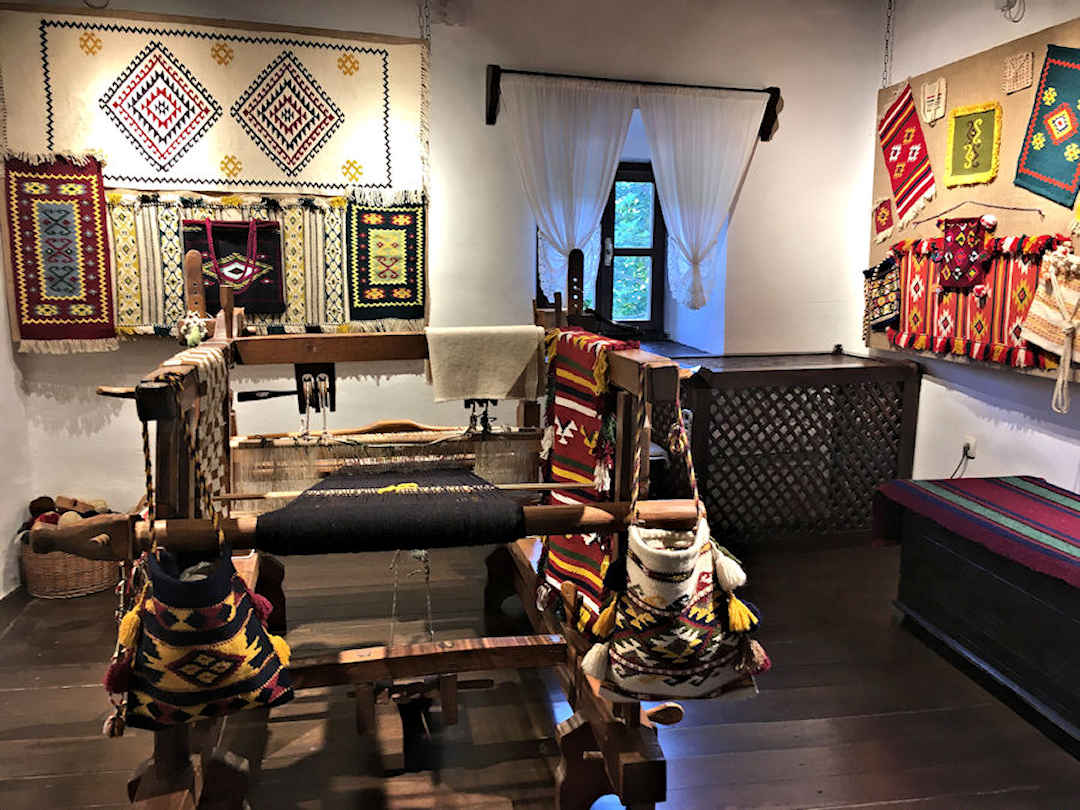
To better understand the cultural significance of the area check out the exhibitions in the restored mill houses at Skradinski Buk
Afterwards, join the boat excursion to Roški Slap (make sure you book in advance), stopping at Visovac Monastery. Enjoy lunch at Roški Slap. Then, walk off the calories, hiking up to Oziđana Pećina Cave (with artefacts between 5,000 and 1,500 BC and stunning views over Roški Slap).
Complete the loop walk around the part of the falls called The Necklaces before taking the boat back to Skradinski Buk. The excursion to Visovac Monastery and Roški Slap will take around four hours.
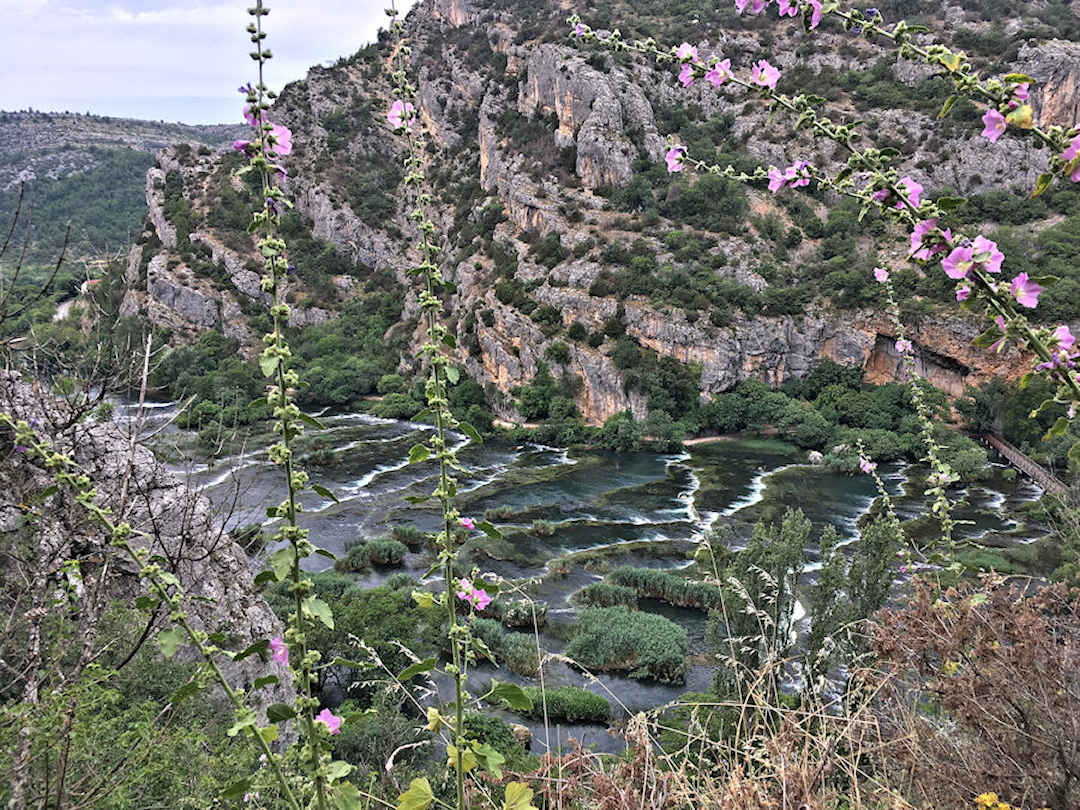
The hike up to Oziđana Pećina Cave may not be for the faint-hearted but the views make more than up for the effort
If you have time, swim at the beach in Skradin (rather than at the waterfall) – the water is cleaner and less crowded.
Stay two nights
Option 1 (no fitness required)
This suggestion includes the two lowest falls (Skradinski Buk and Roški Slap) and the Visovac and Krka Monasteries. It can be done by people who don’t seek physical exercise.
Leave exploring Skradinski Buk for your second morning. Instead, on your first morning, join the boat excursion to Visovac Monastery and Roški Slap, and from there to Krka Monastery and the medieval fortresses Trošenj and Nečven (make sure you book in advance). Have lunch at Roški Slap upon your return from Krka Monastery. The excursions will take up the whole day, including the boat ride between Skradin and Skradinski Buk (and the walk between the jetties).
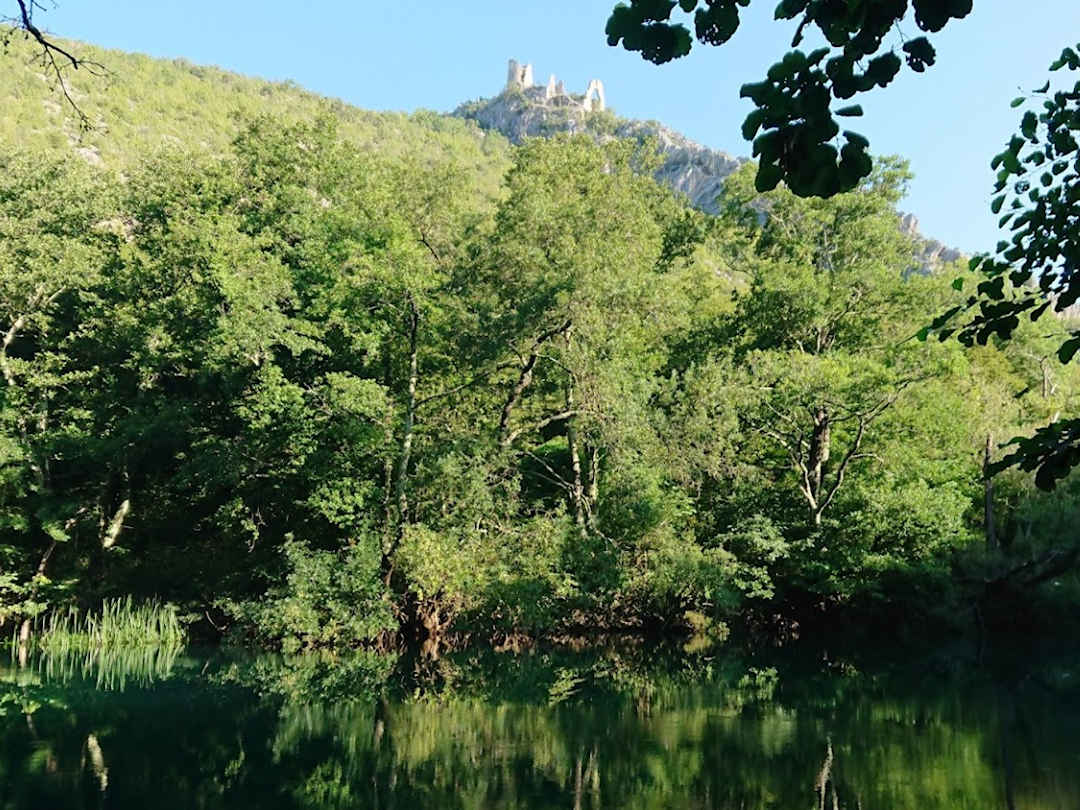
The boat excursion to Krka Monastery also provides a glimpse of the remains of Trošenj, a medieval fortress high above the Krka river
On your second morning, take the boat (back) or hire and ride a bike to Skradinski Buk. Take your time exploring the waterfall on the loop walk and checking out the exhibitions in the restored mill houses. Exploring the falls will take you 2-3 hours.
If you have time, swim at Skradinski Buk or at the beach in Skradin (where the water is cleaner).
Option 2 (requiring a degree of fitness)
This suggestion allows you to explore the two lower waterfalls (Skradinski Buk and Roški Slap) and Visovac Monastery. It also gives you plenty of physical exercise with a 35-km mountain bike ride and an almost vertical hike to Oziđana Pećina Cave.
Explore Skradinski Buk in the morning (refer to above) and then join the boat excursion to Visovac Monastery (make sure you book in advance).
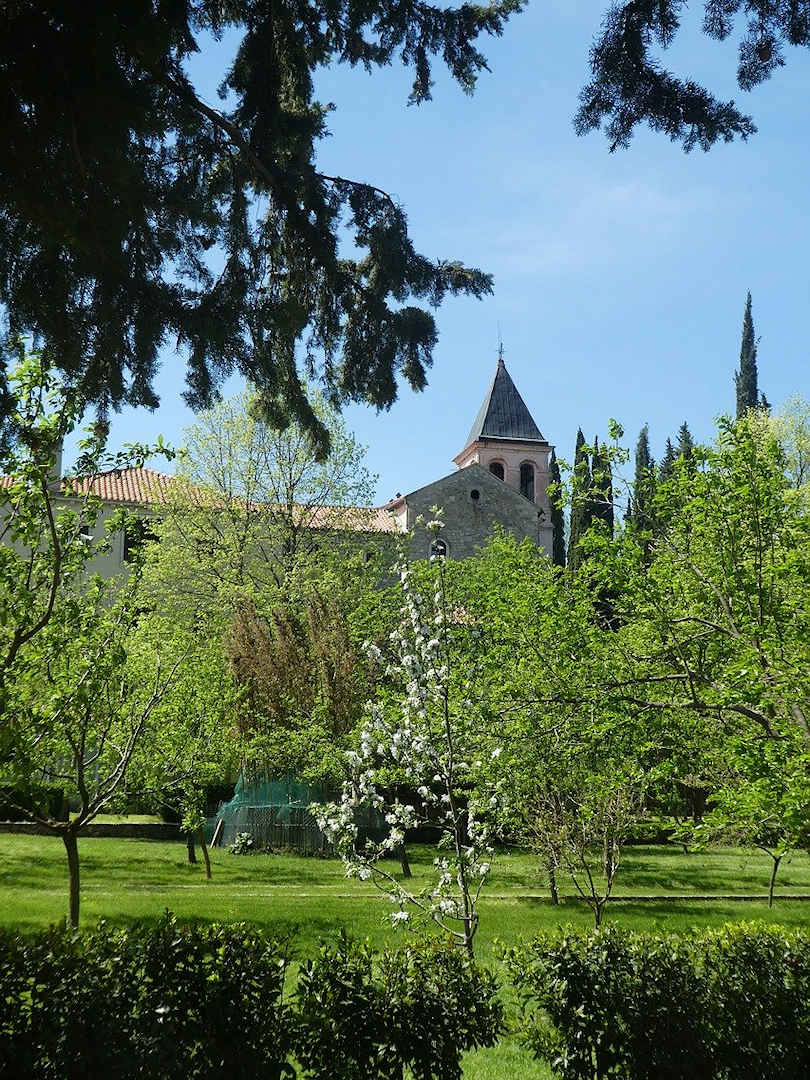
The Franciscan monastery of Visovac makes for a tranquil getaway | Photo by Michel Huché on Pixabay
When you return to Skradinski Buk, have lunch and enjoy an afternoon swim at the beach in Skradin (rather than at the waterfall).
The next morning, hire a bike and ride to Roški Slap, taking the R1 route through Dubravice, Rupe, and Laškovica. Enjoy lunch at Roški Slap. Then, hike up to Oziđana Pećina Cave to check out the archaeological collection and the stunning views over Roški Slap. Complete the loop walk around the part of the falls called The Necklaces before starting your ride back to Skradin (the same way you came).
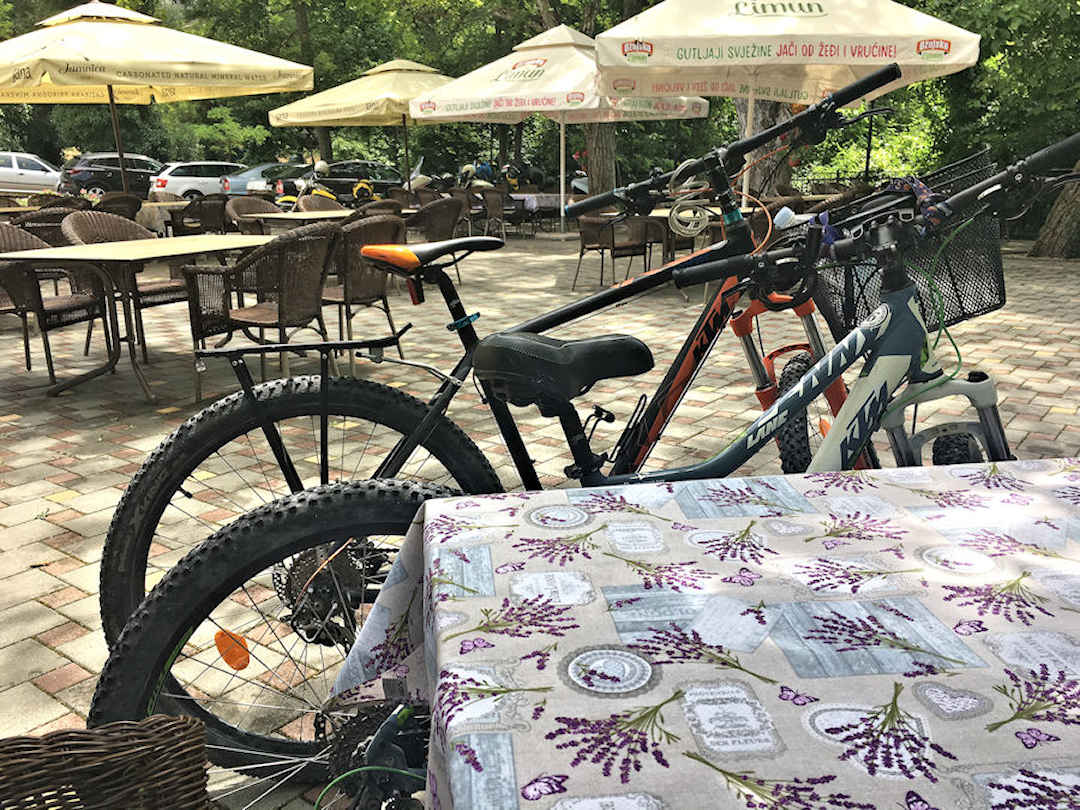
You can hire good quality mountain bikes in Skradin and even join an organised bike tour
If you have visited the Krka National Park recently, what was your experience like? What other tips can you share?
I wrote this Krka National Park Guide based on our own experience. If you’ve visited the Krka National Park, what did you enjoy the most, and what other tips do you have? And if you’re still planning your trip, what other question/s do you have?
Before you go, if you liked our article and found it helpful, we would appreciate it if you could share it with your friends and family via the Share buttons below. Even better: Leave a short review on Trustpilot or Google, which would help us further build our online reputation as a (trustworthy and helpful) travel and lifestyle blog.

